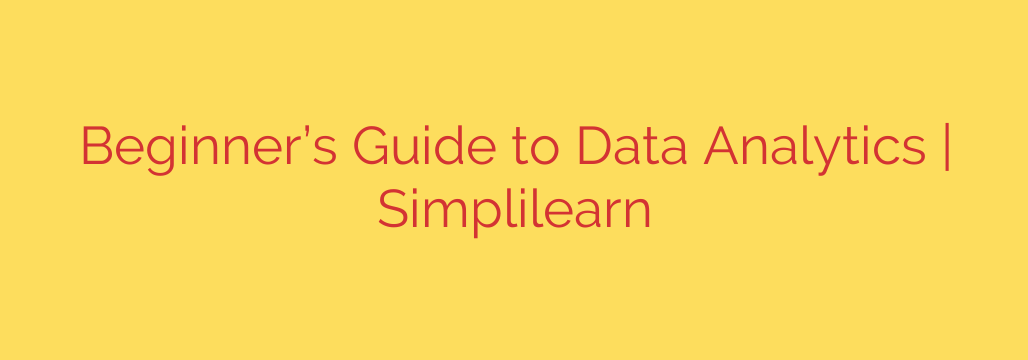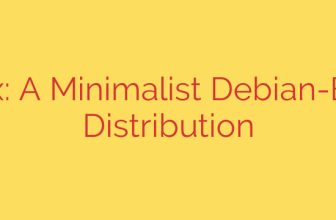
What Is Data Analytics? A Beginner’s Guide to Making Smarter Decisions
In today’s world, we are surrounded by data. Every click, every purchase, and every interaction online generates information. But this massive volume of data is only useful if we can understand it. This is where data analytics comes in—it’s the science of analyzing raw data to uncover hidden patterns, extract valuable insights, and make informed conclusions.
Think of it as transforming a chaotic library of books into a well-organized set of actionable reports. Instead of just having information, you have intelligence. For businesses, this means everything from understanding customer behavior to improving operational efficiency and gaining a powerful competitive edge.
Why Data Analytics is a Game-Changer
Data analytics isn’t just a technical process; it’s a strategic tool that empowers organizations to move from guesswork to data-driven decision-making.
- Improved Decision-Making: By analyzing historical and real-time data, businesses can make faster, more accurate decisions about product development, marketing campaigns, and resource allocation.
- Enhanced Customer Understanding: Analytics helps uncover what customers truly want. By examining purchasing habits, website interactions, and feedback, companies can personalize experiences, improve satisfaction, and build lasting loyalty.
- Operational Efficiency: Identifying bottlenecks in a supply chain, optimizing delivery routes, or predicting equipment maintenance needs are all possible through data analytics. This leads to significant cost savings and smoother operations.
- Risk Mitigation: Financial institutions use analytics to detect fraudulent transactions, while other industries use it to predict market shifts and other potential risks, allowing them to prepare proactively.
The Four Core Types of Data Analytics Explained
Data analytics is not a one-size-fits-all process. It’s best understood as a spectrum of analysis, moving from simple reporting to complex recommendations. These four types build upon each other to provide a complete picture.
1. Descriptive Analytics: What Happened?
This is the foundation of all data analysis. Descriptive analytics summarizes past data to provide a clear picture of what has already occurred. It answers the question, “What happened?”
- Examples: A monthly sales report, website traffic statistics from Google Analytics, or a dashboard showing the number of new customers acquired in the last quarter.
- Purpose: To monitor key performance indicators (KPIs) and identify trends over time.
2. Diagnostic Analytics: Why Did It Happen?
Once you know what happened, the next logical question is why. Diagnostic analytics digs deeper into the data to find the root causes of an outcome.
- Examples: If a sales report shows a sudden drop in a specific region (Descriptive), a diagnostic analysis might reveal that a competitor launched a major discount campaign in that area.
- Purpose: To understand the factors and relationships that led to a particular event.
3. Predictive Analytics: What Will Happen Next?
This is where the analysis starts looking to the future. Predictive analytics uses historical data, statistical algorithms, and machine learning techniques to forecast future outcomes.
- Examples: Forecasting product demand for the next holiday season, identifying customers who are likely to churn (cancel their subscription), or predicting which sales leads are most likely to convert.
- Purpose: To anticipate future trends and prepare for them proactively.
4. Prescriptive Analytics: What Should We Do About It?
This is the most advanced form of analytics. Prescriptive analytics not only predicts what will happen but also recommends specific actions to take to achieve a desired outcome or mitigate a future risk.
- Examples: An airline’s pricing algorithm automatically adjusting ticket prices based on demand to maximize revenue, or a GPS app recommending an alternate route to avoid traffic.
- Purpose: To provide clear, data-backed recommendations that guide strategic decisions.
The Step-by-Step Data Analytics Process
While the tools may vary, the core process for conducting data analysis follows a consistent, logical path.
- Define the Objective: The first and most critical step is to clearly define the business question you are trying to answer. A vague goal leads to a vague analysis.
- Collect the Data: Once the objective is set, you must gather relevant data from various sources, such as company databases, customer relationship management (CRM) systems, social media, or third-party datasets.
- Clean and Prepare the Data: Raw data is almost never perfect. This step involves removing errors, handling missing values, and eliminating duplicates. This is often the most time-consuming part of the process, but it is essential for accurate results.
- Analyze the Data: This is where you apply the appropriate analytical techniques—be it descriptive, diagnostic, predictive, or prescriptive—using statistical models and specialized software to uncover insights.
- Interpret and Visualize the Results: The final step is to translate your findings into a story that stakeholders can understand. This is often done through data visualization tools like charts, graphs, and interactive dashboards, making complex information easy to digest and act upon.
Essential Tools of the Modern Data Analyst
A successful data analyst relies on a powerful toolkit to perform their work effectively. While the list of tools is constantly evolving, some of the most fundamental include:
- Programming Languages: Python and R are the two dominant languages in data science, offering extensive libraries for data manipulation, statistical analysis, and machine learning.
- Database Querying: SQL (Structured Query Language) is the universal language for managing and retrieving data from relational databases. Proficiency in SQL is non-negotiable for any data professional.
- Data Visualization Platforms: Tools like Tableau and Microsoft Power BI allow analysts to create stunning, interactive dashboards and reports without needing to write code.
- Spreadsheet Software: Programs like Microsoft Excel and Google Sheets remain indispensable for quick data manipulation, basic analysis, and ad-hoc reporting.
Getting Started: Your Path to a Career in Data Analytics
Embarking on a journey in data analytics is an exciting prospect. Here are a few actionable steps to begin:
- Build a Strong Foundation: Focus on the fundamentals of mathematics, statistics, and probability. A solid understanding of these concepts is crucial for interpreting data correctly.
- Learn Key Programming Languages: Start with SQL to master data retrieval. Then, choose either Python or R and learn its core data science libraries (like Pandas and Matplotlib for Python).
- Master Data Visualization: Gain hands-on experience with a tool like Tableau or Power BI. Many offer free versions for personal use.
- Build a Portfolio: The best way to learn is by doing. Find public datasets on platforms like Kaggle and work on projects that answer interesting questions. A strong portfolio showcasing your skills is more valuable than any certificate.
The future is data-driven, and the ability to analyze and interpret data is no longer a niche skill—it’s a core competency for success in any industry. By understanding the what, why, and how of data analytics, you can begin your journey toward turning raw information into powerful, decisive action.
Source: https://www.simplilearn.com/data-analytics-basics-beginners-guide-pdf








